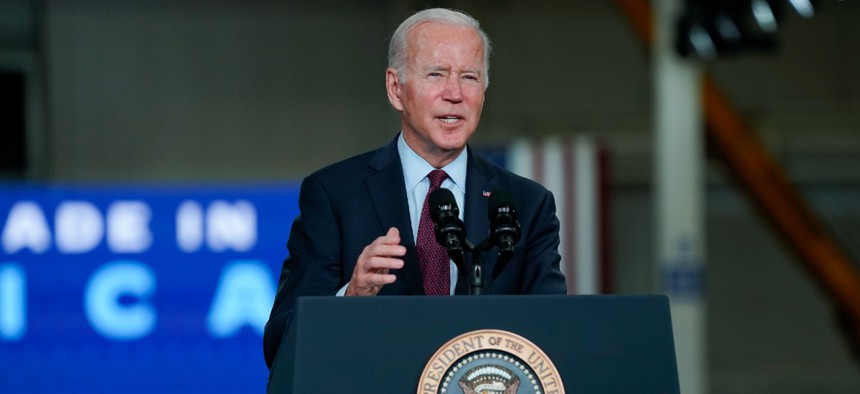Biden’s Management Agenda Highlights Need for High-Tech Federal Workforce

President Joe Biden speaks during a visit to the General Motors Factory ZERO electric vehicle assembly plant Nov. 17. Evan Vucci/AP
To deliver better citizen services, the government will need a skilled workforce and the technology to support it, management officials said.
The Biden administration’s governing ethos for the next three to seven years will focus on the federal workforce, improvements to citizen services and better management of government time and resources, all of which will include a technology component, according to the White House.
The Office of Management and Budget released a document Wednesday evening outlining the broad vision of the President’s Management Agenda, which sets up the guiding principles by which the Biden administration will operate.
“The vision is the launch of our PMA,” OMB Deputy Director for Management Jason Miller said during a call with reporters. “It outlines our values and tethers our work around three priorities.”
Miller said there is no hard timeline for releasing additional guidance or specific programs and policies but said there would be more coming out in the weeks and months ahead.
The PMA vision document centers on three pillars: strengthening and empowering the federal workforce; delivering excellent, equitable and secure federal services and customer experience; and managing the business of government to build back better.
As with the last administration, the Biden PMA includes an acknowledgement of technology’s role in achieving each of these larger goals.
“Technology is an enabler across the entirety of this agenda,” Miller said in response to a question. “Whether that’s both powering our personnel systems by making sure we have the right tech talent in the federal government, strengthening our delivery systems.”
Miller said the administration will use existing resources like the U.S. Digital Service and Technology Modernization Fund to support these efforts, as well.
Under a section titled “How We Will Get There,” officials noted the importance of federal IT and cybersecurity.
“Cybersecurity and IT modernization are critical tools that must be at the foundation of government management,” the document states. “We will continue to bolster federal cybersecurity and ensure that secure systems help deliver government services.”
The PMA also cites the importance of a technically skilled workforce to build and manage those IT assets.
“To better prepare for our future, we also must identify and address critical skills gaps across the federal IT and cybersecurity workforce,” the document states, though it does not offer further details on how those gaps will be identified and addressed.
With regard to supporting its own workforce, the PMA notes lessons learned from the pandemic have shown the importance of quality collaboration tools, cloud computing and automation to the future of government work.
“By utilizing expanded flexibilities in work arrangements, such as expanded telework and alternative work schedules, and increased adoption of technology, … the government will enhance its ability to recruit and retain top talent, staying competitive with broader trends in how Americans work,” the document states.
The PMA also acknowledges the importance of federal technology for the rest of the country, including better services for citizens and pushing technological advancements in the private sector.
The agenda includes a heavy emphasis on the customer experience side of citizen services, with the first strategy of that pillar focused on “the service design, digital products and customer-experience management of federal High-Impact Service Providers,” a special designation for citizen-facing services that touch lots of Americans or have a critical impact on society. The PMA includes building better digital experiences for such services.
“Every single interaction with the government is an opportunity to deliver the value and meet and exceed the expectations of the people we serve,” Miller said.
The future of federal customer experience improvement efforts will focus on “key life experiences,” Miller said. “Moments for our customers that are critical to them and they interact with the federal government, oftentimes in multiple places.”
OMB plans to start by identifying an initial set of such life experiences—“Whether it’s experiencing a disaster and trying to access the federal government to support recovery or a life event like retirement or losing a job,” Miller said—then build cross-agency teams to design holistic services around those situations.
The PMA also looks outward to the private sector, particularly with regard to how the government’s buying patterns affect the marketplace.
“The federal government—as an enterprise—influences and reshapes markets, supports key supply chains, drives progress on new technology and solution development, and provides key support into communities throughout the country,” the PMA states.
In that vein, the PMA looks to continue past administrations’ efforts to centralize procurement and use federal acquisition to move markets, including new measures to increase purchases of domestic products.
The document also notes ways in which the administration can use federal procurement to combat climate change and social inequities.
NEXT STORY: FCW Insider: November 18, 2021






